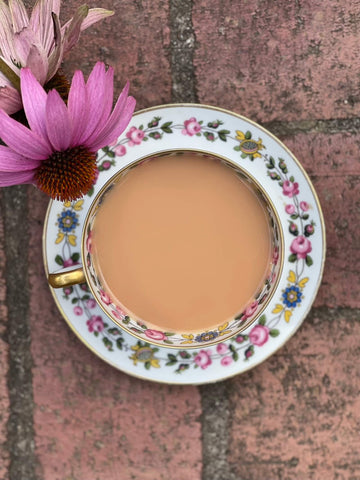No Products in the Cart

I’m sure you’ve been there, faced with pronouncing an unfamiliar word from an unfamiliar language or culture. Whether it be at a local restaurant, store, or event, you have to ask for the item in person, realizing you have absolutely no idea how to pronounce this unfamiliar word and face the possible embarrassment of getting it completely wrong. It is a learning experience for sure. It’s not, however, just the pronunciation that can be a problem. Sometimes words from other cultures are fused into the everyday English lexicon and used in an incorrect fashion. The world of tea is no exception.

Walk into any coffee shop or cafe in the United States and you are likely to find ‘chai tea’ or ‘chai tea latte’ on the menu. While this is a familiar drink to many, chai is simply used to refer to tea in India. Hence the menu is advertising a tea tea or tea tea latte! What we call tea in the western world actually comes from two root words: Te and Cha. Both words come from the same Chinese character (茶) but the character is pronounced ‘cha’ in mandarin Chinese and ‘te’ in Min Chinese. The spreading and adoption of these terms developed through different trading routes and partnerships which gave rise to the now eponymous phase “cha by land, te by sea” (although, this is a simplification). The Portuguese were the first to reach Asia and trade tea. Having colonized Formosa (modern day Taiwan), the Portuguese traded through the port of Macao where the pronunciation ‘cha’ was used. Later (around 1607), Dutch traders encountered tea in the coastal regions of modern-day Fujian where the local pronunciation of tea was ‘te’. The Dutch traded with the people of Fujian and brought this tea back across the oceans to parts of west and south Africa and western Europe who then adopted variations of the word te. In contrast, horse-caravans that moved tea along the silk road spread the word cha to the Persian empire (which became chay). From here, trade routes took tea to India, Russia, Turkey, Arabia, and East Africa who used variations of this pronunciation, which included the hindi word chai.
The typical western use of the word chai refers to a spiced tea known as masala chai (where masala refers somewhat generically to a combination of spices). In its most common form, the masala spices consist of cardamom, ginger, black peppercorn, cloves, and cinnamon. The spices are then ground and boiled with strong black CTC tea, milk, and sweetener. However, there are no fixed proportions to these elements and each region or family may have their own variation of the spices used.

Another popular variation of masala chai is known as Bombay (Mumbai) cutting chai. The cutting refers to a full cup being cut into half which reduces the cost, the time taken to drink (Mumbai is a buzzing, fast moving metropolis), and increases the number of cups that can be had throughout the day. Cutting chai is usually made extremely strong, flavorful, and aromatic to make up for the small quantity.
Now that you are aware of the true meaning of the word chai and the western interpretation of the word, try making your own masala chai with our blend here. Just follow the recipe that has been perfected by your Chaiwalla Tiger at Herbs and Kettles below :